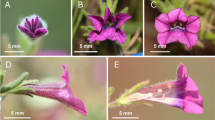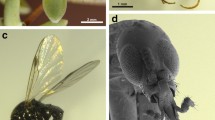Abstract
The exines of pollen grains ofHibbertia stricta (DC.)R. Br. exF. Muell. (Sect.Pleurandra) wear an oily, yellow pollen coat that stains positively for lipids. The pollen is collected by asocial bees, exclusively. The most common floral foragers are members of the genusLasioglossum (subgenusChilalictus;Halictidae) and they harvest pollen via thoracic vibration. As these bees cling to the inflated anthers their pollen smeared bodies come in contact with either of the two wet, nonpapillate stigmas. The stigmas respond positively to cytochemical tests for the presence of esterase immediately following expansion of the corolla, indicating the effective pollination period. The foraging patterns of the bees are narrowly to broadly polylectic. AsH. stricta flowers are nectarless, it is not surprising that bees bearing mixed pollen loads always carry the pollen of at least one nectariferous, coblooming plant. The pollination biology ofH. stricta is compared with otherHibbertia spp. and with “pollen flowers” in general.
Similar content being viewed by others
References
Armstrong, J. A., 1979: Biotic pollination mechanisms in the Australian flora—a review. — New Zeal. J. Botany17, 467–508.
Bernhardt, P., 1983: Insect pollination of AustralianAcacia. InWilliams, E. B., Knox, R. B., Gilbert, J. H., Bernhardt, P., (Eds.): Pollination '82: Proceedings of a Symposium held at the Plant Cell Biology Research Centre, pp. 84–101. Melbourne: University Press.
—, 1980: Floral biology and self-incompatibility in some Australian mistletoes of the genusAmyema. — Aust. J. Bot.28, 437–451.
—, 1979: The pollination ecology ofEcheandia macrocarpa (Liliaceae). — Brittonia31, 64–71.
-Walker, K., (in press): Bee foraging on three species of AustralianAcacia. — International J. of Entomology.
Bowers, K. A. W., 1975: The pollination ecology ofSolanum rostratum. — Amer. J. Bot.62, 633–638.
Cronquist, A., 1981: An Integrated System of Classification of Flowering Plants. — Columbia University Press.
Dickison, W. C., 1969: Comparative morphological studies inDilleniaceae. IV. Anatomy of the node and vascularization of the leaf. — J. Arnold Arbor. Harv. Univ.50, 384–410.
Dulberger, R., 1981: The floral biology ofCassia didymotrya andC. auriculata (Caesalpiniaceae). — Amer. J. Bot.68, 1350–1360.
—, 1980: Floral morphology and reproductive biology of four species ofCyanella (Tecophilaeaceae). — New Phytol.86, 45–56.
Free, J. B., 1970: Insect Pollination of Crops. — London and New York: Academic Press.
Heslop-Harrison, Y., Shivanna, K. R., 1977: The receptive stigma of the angiosperm stigma. — Ann. Bot.41, 1233–1258.
Keighery, G. J., 1975: Pollination ofHibbertia hypericoides (Dilleniaceae) and its evolutionary significance. — J. Nat. Hist.9, 681–684.
Kenrick, J., Knox, R. B., 1979: Pollen development and cytochemistry in some Australian species ofAcacia. — Aust. J. Bot.29, 413–427.
Macior, L. W., 1974: Behavioural aspects of coadaptations between flowers and insect pollinators. — Ann. Missouri Bot. Gard.61, 760–769.
Michener, C. D., 1979: Biogeography of the bees. — Ann. Mo. Bot. Gard.66, 277–347.
Moore, P. D., 1983: Beetle vectors. — Nature301, 462.
Ogden, E. C., Raynor, G. S., Hayers, J. V., Lewis, D. M., Haints, J. H., 1974: Manual of Sampling Airborne Pollen. — London, U.K.
Pearse, A. G., 1972: Histochemistry. Theoretical and Applied. Vol. 2, 2nd edition. — London: Churchill.
Prance, G. G., Anderson, A. B., 1976: Studies of the floral biology of neotropicalNymphaeaceae 3. — Acta Amazonica6, 163–170.
Schneider, E., 1979: Pollination biology of theNymphaeaceae. — InCaron, D. M., (Ed.): Proceedings of the IVth International Symposium on Pollination. — Maryland Ag. Exp. Sta. Spec. Misc. Publ.1, 419–430.
Specht, R. K., Rose, E. M., Boughton, V. H., 1974: Conservation of major plant communities in Australia and Papua New Guinea. — Aust. J. Bot. Suppl. Ser.7, 1–667.
Stebbins, G. L., 1974: Flowering Plants: Evolution above the Species Level. — Cambridge, Harvard: Belknap.
—, 1976: Species diversity, ecology and evolution in a primitive angiosperm genus:Hibbertia (Dilleniaceae). — Pl. Syst. Evol.125, 139–154.
Thien, L. B., 1980: Patterns of pollination in the primitive angiosperms. — Biotropic12, 1–13.
Vogel, St., 1978: Evolutionary shifts from reward to deception in pollen flowers. — InRichards, A. J., (Ed.): The Pollination of Flowers by Insects, pp. 89–96. — Linn. Soc. Symp. No.6. London: Academic Press.
Willis, J. H., 1978: A Handbook to Plants in Victoria. Vol.II, Dicotyledons, 2. ed. — Melbourne: University Press.
Author information
Authors and Affiliations
Rights and permissions
About this article
Cite this article
Bernhardt, P. The pollination biology ofHibbertia stricta (Dilleniaceae). Pl Syst Evol 147, 267–277 (1984). https://doi.org/10.1007/BF00989388
Received:
Revised:
Issue Date:
DOI: https://doi.org/10.1007/BF00989388




